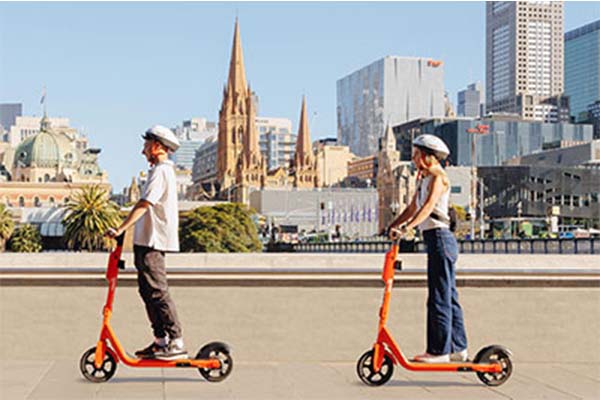With the NSW e-scooter trials well under way, Patrick Hatch’s article in The Age concerning a pedestrian injured by a rider on a rental e-scooter in Melbourne, raises important issues regarding rights, responsibilities and the allocation of space on public roads. Julia Miller was walking on a footpath when she was struck by a person on an e-scooter. She suffered extensive injuries (totalling $15000). However, due to a loophole in the scheme that voids Lime and Neuron’s insurance if riders are not wearing helmets, riding on footpaths or have broken any other rule’ (Patrick Hatch) her compensation is uncertain.

(Photo courtesy of 2022 City of Melbourne e-scooter trial)
Transport for NSW's Road User Space Allocation Policy
On the question of rights and responsibilities, pedestrians' right of way is embedded into Transport for NSW’s Road User Space Allocation Policy. This policy recognises that streets aren’t just corridors for cars. Streets are important places where people move and live. It also establishes a hierarchy where pedestrians/ wheelchairs/ prams come first. Then, bicycles/scooters, then public transport, then delivery vehicles and lastly private cars. The policy comes from The Portland Model and is universally accepted as canon for liveable, breathable cities.
On the issue of liability, placing responsibility on victims is manifestly unfair. It is also a disincentive to expect vendors to wear the cost after conditions of hire have been breached. If the government wants the substantial economic benefit to health, the environment, the economy, and decongestion that mass adoption of these devices can generate, there’s a third option. New Zealand has a government-funded no-fault injury compensation model.
Parliamentary Advisory Council on Transport Safety
E-scooters are fun, accessible, and ubiquitous. However to a higher centre of gravity, they’re less stable than bicycles and require regulation particularly regarding safety, speed, design and use. Spurred by the pandemic, the UK Government permitted e-scooter trials in 2020, similar to the current Australian trials, but on a massive scale. There are now 23,000 regulated rental e-scooters in 31 areas and over one million imported since 2019. The Parliamentary Advisory Council on Transport Safety has recommended: 20 kmph speed limits, mandatory helmets, no riding on footpaths, an 18+ age limit, …and no doubling! Transport for NSW have confirmed the NSW trial parameters will also include 20km speed limits on cycle ways (10kmph on shared paths) and use on footpaths will be disallowed.

Photo: iStock, credit Ceri Breeze
E-Scooters Are An Emerging Force
As an emerging force in the active transport mix and global effort to decarbonise, such trials demonstrate the need for separated paths and reduced speed limits on non-arterial roads. Cyclists and scooters are then no longer on footpaths. Separation is preferable i.e. scooters on cycle paths and roads. Geofencing- the use of satellite mapping to determine where e-scooters can and can’t ride, is feasible for hire companies but not privately owned vehicles. The trials also indicate that alongside active transport participation, is a growing need for common courtesy. The roads are there to share.
NSW Roads Are Unsafe
‘This brings us back to first principles,’ says Peter McLean, CEO of Bicycle NSW. ‘Roads are public spaces and should not be the monopoly of private cars travelling at speed in built up areas. It’s easy to focus on the 20-year-old who broke the law and injured a pedestrian but why was they on the footpath in the first place? Because the roads are unsafe.’
‘Bicycle NSW will be observing the NSW e-scooter trial closely and looks forward to providing further feedback and advice once further data is available.’ Peter McLean said.
Each year, cars in NSW kill 113 pedestrians (with many more injured). ‘In the 12 months to April 2022, Australia reported 1157 road deaths, a 4.2 percent increase on the previous year’ (Mary Ward, The Age). Cars are a leading cause of childhood death.
Any injuries are terrible and unacceptable, which is why Bicycle NSW asks you to join our campaign for better active transport infrastructure, safe paths to school and 30km speed limits on non-arterial roads.

